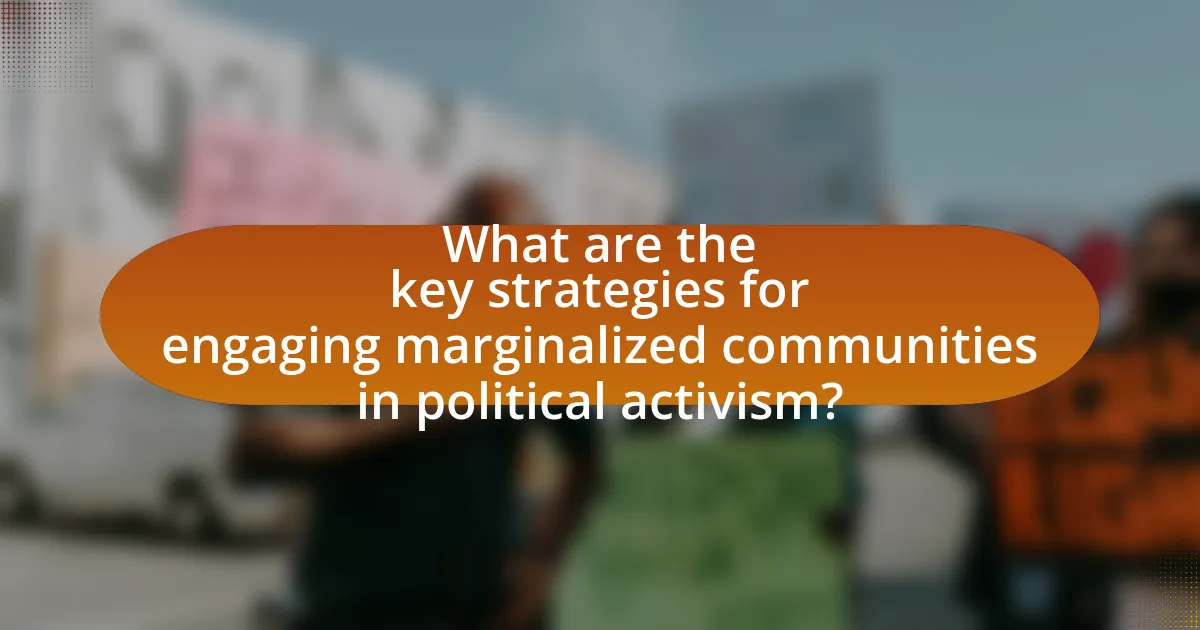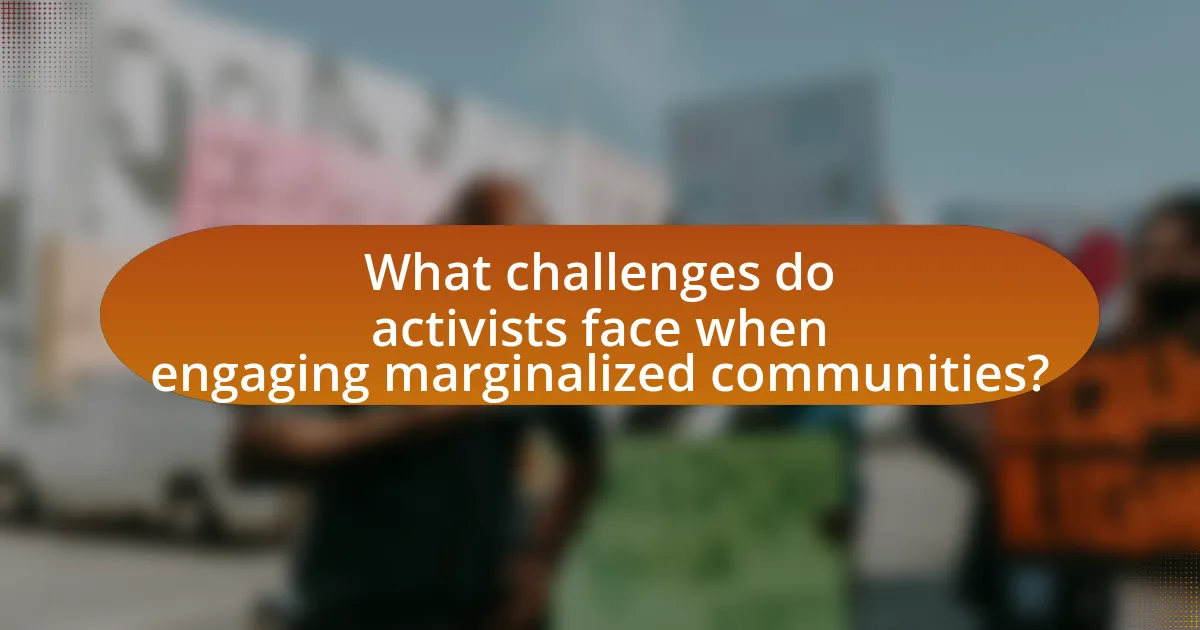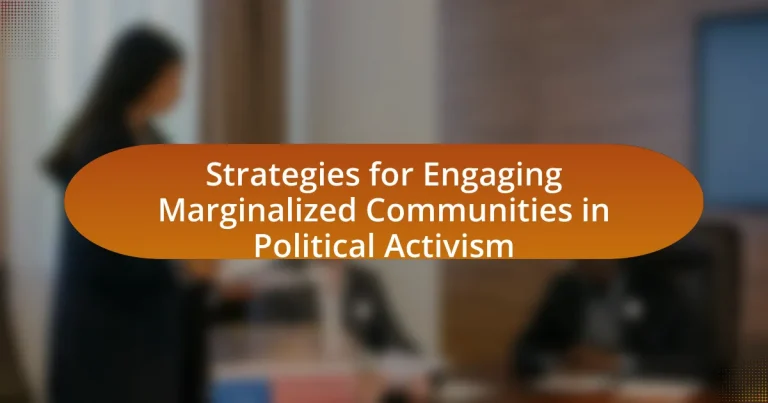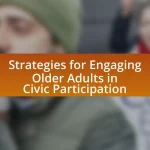The article focuses on strategies for engaging marginalized communities in political activism, emphasizing the importance of building trust, fostering inclusive dialogue, and providing accessible resources. Key methods for assessing community needs include participatory research, which enhances engagement by aligning strategies with specific interests and challenges. Cultural factors and systemic discrimination are discussed as significant influences on the engagement process, while collaboration with local leaders and organizations is highlighted as a means to improve outreach and participation. The article also addresses the challenges activists face, such as historical mistrust and socioeconomic barriers, and offers practical tips for effective engagement, including the use of technology and educational initiatives to empower these communities.

What are the key strategies for engaging marginalized communities in political activism?
Key strategies for engaging marginalized communities in political activism include building trust, fostering inclusive dialogue, and providing accessible resources. Building trust involves establishing genuine relationships through consistent engagement and understanding community needs. Fostering inclusive dialogue ensures that all voices are heard, which can be achieved through community forums and participatory decision-making processes. Providing accessible resources, such as educational materials and training on civic engagement, empowers individuals to participate actively. Research indicates that these strategies enhance participation rates and strengthen community ties, as evidenced by initiatives like the “Participatory Budgeting Project,” which has successfully engaged diverse communities in local governance.
How can understanding community needs enhance engagement strategies?
Understanding community needs enhances engagement strategies by allowing organizations to tailor their approaches to the specific interests and challenges faced by the community. When engagement strategies are aligned with the actual needs of the community, they become more relevant and effective, leading to increased participation and trust. For instance, research by the Urban Institute indicates that community-driven initiatives that address local priorities result in higher levels of civic engagement and satisfaction among residents. By actively listening to community members and incorporating their feedback, organizations can foster a sense of ownership and empowerment, which is crucial for sustained political activism.
What methods can be used to assess the needs of marginalized communities?
To assess the needs of marginalized communities, participatory research methods are effective. These methods involve engaging community members directly in the research process, allowing them to share their experiences and priorities. For instance, focus groups and community surveys can gather qualitative and quantitative data, ensuring that the voices of marginalized individuals are heard. A study by the Urban Institute highlights that participatory approaches lead to more accurate assessments of community needs, as they incorporate the perspectives of those most affected by social issues.
How do cultural factors influence the engagement process?
Cultural factors significantly influence the engagement process by shaping individuals’ values, beliefs, and communication styles. For instance, cultural norms dictate how communities perceive authority and participation, which can either facilitate or hinder political activism. Research indicates that marginalized communities often have distinct cultural identities that affect their willingness to engage in political processes; for example, a study by the Pew Research Center found that cultural ties can enhance community cohesion, leading to increased collective action. Additionally, understanding cultural contexts allows activists to tailor their strategies, ensuring that messaging resonates with specific groups, thereby improving engagement outcomes.
What role does trust play in engaging marginalized communities?
Trust is essential for effectively engaging marginalized communities, as it fosters open communication and collaboration. When marginalized groups perceive that organizations or individuals genuinely care about their needs and concerns, they are more likely to participate in political activism. Research indicates that trust can significantly enhance community involvement; for instance, a study by the Urban Institute found that trust in community leaders correlates with higher rates of civic engagement among marginalized populations. This trust is built through consistent, transparent actions and a history of positive interactions, which ultimately empower these communities to advocate for their rights and interests.
How can activists build trust within these communities?
Activists can build trust within marginalized communities by actively engaging with community members, listening to their concerns, and demonstrating a genuine commitment to their needs. This approach fosters open communication and shows that activists value the perspectives of the community. Research indicates that trust is built through consistent, transparent actions and by establishing long-term relationships rather than short-term interactions. For instance, a study by the Urban Institute highlights that community-based participatory research, which involves community members in the research process, significantly enhances trust and collaboration between activists and the community.
What are the consequences of a lack of trust in political activism?
A lack of trust in political activism leads to decreased participation and engagement from communities, particularly marginalized groups. When individuals do not trust political movements or organizations, they are less likely to participate in campaigns, vote, or advocate for change, resulting in diminished representation and voice in the political process. Research indicates that trust is a critical factor in mobilizing communities; for instance, a study by the Pew Research Center found that communities with higher levels of trust in political institutions are more likely to engage in civic activities. Consequently, the erosion of trust can perpetuate systemic inequalities and hinder social progress.
How can collaboration with local leaders improve engagement?
Collaboration with local leaders can significantly improve engagement by leveraging their established trust and influence within the community. Local leaders possess intimate knowledge of the community’s needs and concerns, which allows for tailored communication and initiatives that resonate with residents. For instance, a study by the Urban Institute found that community-based organizations that partnered with local leaders saw a 40% increase in participation rates for civic activities. This demonstrates that when local leaders are involved, marginalized communities are more likely to engage in political activism, as they feel their voices are represented and valued.
What types of local leaders are most effective in this context?
Effective local leaders in the context of engaging marginalized communities in political activism are those who demonstrate strong community ties, cultural competence, and inclusive communication skills. Leaders who are deeply rooted in their communities understand the unique challenges and needs of marginalized groups, allowing them to build trust and foster collaboration. Research indicates that leaders who prioritize participatory approaches, such as community organizing and grassroots mobilization, are particularly successful in empowering marginalized voices. For instance, studies show that local leaders who actively involve community members in decision-making processes can significantly enhance political engagement and advocacy efforts, leading to more effective outcomes in activism.
How can partnerships with local organizations enhance outreach?
Partnerships with local organizations enhance outreach by leveraging established trust and networks within communities. Local organizations often have deep-rooted connections and understanding of the specific needs and concerns of marginalized groups, which can facilitate more effective communication and engagement. For instance, a study by the Urban Institute found that community-based organizations significantly improve participation rates in civic activities by providing culturally relevant information and support. This localized approach not only increases awareness but also fosters a sense of ownership and empowerment among community members, leading to higher levels of political activism and engagement.

What challenges do activists face when engaging marginalized communities?
Activists face significant challenges when engaging marginalized communities, primarily due to historical mistrust and systemic barriers. Marginalized groups often have a history of exploitation and neglect by institutions, leading to skepticism towards activists and their intentions. Additionally, language barriers and cultural differences can hinder effective communication, making it difficult for activists to convey their messages and build rapport. Economic constraints also play a role, as many marginalized individuals may prioritize immediate survival needs over political engagement. Research indicates that these factors contribute to lower participation rates in activism among these communities, as seen in studies highlighting the impact of socioeconomic status on civic engagement.
What barriers exist that hinder participation in political activism?
Barriers that hinder participation in political activism include socioeconomic factors, lack of access to information, and systemic discrimination. Socioeconomic factors, such as poverty and lack of education, limit individuals’ ability to engage in activism due to time constraints and financial instability. A study by the Pew Research Center found that individuals with lower income levels are less likely to participate in political activities compared to those with higher incomes. Additionally, lack of access to information, including awareness of issues and available platforms for activism, can prevent marginalized communities from engaging effectively. Systemic discrimination, including racial and gender biases, further exacerbates these barriers, as marginalized groups may face hostility or exclusion in political spaces.
How do socioeconomic factors impact engagement levels?
Socioeconomic factors significantly impact engagement levels in political activism by influencing access to resources, education, and social networks. Individuals from lower socioeconomic backgrounds often face barriers such as limited financial resources, which restrict their ability to participate in political activities, including attending events or contributing to campaigns. Research indicates that communities with higher poverty rates exhibit lower voter turnout, as seen in the 2020 U.S. elections where areas with median incomes below $30,000 had turnout rates approximately 10% lower than wealthier neighborhoods. Additionally, education levels, which correlate with socioeconomic status, affect political knowledge and efficacy, further diminishing engagement among marginalized groups.
What role does systemic discrimination play in these challenges?
Systemic discrimination significantly exacerbates the challenges faced by marginalized communities in political activism. This form of discrimination manifests through institutional policies and societal norms that disadvantage specific groups based on race, gender, socioeconomic status, or other characteristics. For instance, research by the American Psychological Association indicates that systemic barriers, such as voter ID laws and gerrymandering, disproportionately affect minority populations, limiting their political participation. Consequently, these systemic inequities hinder the ability of marginalized communities to engage effectively in political activism, as they face additional obstacles that their more privileged counterparts do not encounter.
How can activists overcome resistance from marginalized communities?
Activists can overcome resistance from marginalized communities by building trust through genuine relationships and understanding their unique needs. Engaging in active listening and demonstrating cultural competence allows activists to align their goals with the community’s priorities. Research indicates that when activists prioritize community involvement and co-create solutions, resistance decreases significantly. For instance, a study by the Urban Institute found that participatory approaches in community organizing lead to higher levels of trust and collaboration, ultimately fostering a more receptive environment for activism.
What strategies can be employed to address skepticism towards activism?
To address skepticism towards activism, employing transparent communication and community engagement strategies is essential. Transparent communication involves sharing clear, factual information about the goals, methods, and impacts of activism, which can help demystify the process and build trust. Community engagement strategies, such as organizing local forums or workshops, allow individuals to voice their concerns and ask questions, fostering a sense of inclusion and understanding. Research indicates that when activists actively involve skeptics in discussions and decision-making, it can lead to increased support and participation, as seen in studies conducted by the Stanford Social Innovation Review, which highlight the importance of dialogue in overcoming distrust.
How can activists effectively communicate their goals to the community?
Activists can effectively communicate their goals to the community by utilizing clear messaging, engaging storytelling, and leveraging multiple communication channels. Clear messaging ensures that the goals are easily understood, while engaging storytelling helps to connect emotionally with the audience, making the issues more relatable. For instance, studies show that narratives can increase empathy and motivate action, as evidenced by research from the Stanford Social Innovation Review, which highlights the power of storytelling in social movements. Additionally, using various channels such as social media, community meetings, and local events allows activists to reach diverse audiences, ensuring that their message resonates across different demographics.

What best practices can enhance the effectiveness of engagement strategies?
To enhance the effectiveness of engagement strategies, organizations should prioritize building trust through consistent communication and active listening. Establishing trust fosters a sense of safety and encourages participation among marginalized communities. Research indicates that when organizations engage in transparent dialogue and demonstrate genuine interest in community concerns, they significantly increase the likelihood of sustained involvement. For instance, a study by the Urban Institute found that community engagement initiatives that prioritize relationship-building lead to higher participation rates and more impactful outcomes.
How can technology be leveraged to engage marginalized communities?
Technology can be leveraged to engage marginalized communities by providing accessible platforms for communication, information sharing, and mobilization. For instance, social media platforms enable marginalized groups to voice their concerns, organize events, and connect with allies, thereby amplifying their messages. Research shows that 70% of marginalized individuals use social media to engage in political discussions, highlighting its effectiveness as a tool for activism. Additionally, mobile applications can facilitate access to resources, such as legal aid and health services, which are crucial for these communities. By utilizing technology, organizations can create targeted outreach campaigns that address specific needs, ensuring that marginalized voices are heard and represented in political discourse.
What digital tools are most effective for outreach and communication?
Social media platforms, email marketing tools, and messaging apps are the most effective digital tools for outreach and communication. Social media platforms like Facebook, Twitter, and Instagram enable organizations to reach diverse audiences quickly and engage them through targeted content. Email marketing tools such as Mailchimp and Constant Contact facilitate direct communication with supporters, allowing for personalized outreach and updates. Messaging apps like WhatsApp and Telegram provide instant communication channels that can foster community building and real-time engagement. These tools have been shown to increase participation and mobilization efforts, particularly among marginalized communities, by providing accessible and immediate means of communication.
How can social media campaigns be tailored to resonate with these communities?
Social media campaigns can be tailored to resonate with marginalized communities by incorporating culturally relevant content and addressing specific issues that matter to those groups. Understanding the unique challenges and values of these communities allows campaign creators to craft messages that reflect their experiences and aspirations. For instance, research shows that campaigns featuring authentic voices from within the community, such as local leaders or influencers, significantly increase engagement and trust. Additionally, using platforms popular among these demographics, such as Instagram or TikTok, can enhance visibility and participation. Data from the Pew Research Center indicates that 69% of adults in the U.S. use social media, making it a vital tool for outreach. By prioritizing inclusivity and representation in messaging, social media campaigns can effectively mobilize and empower marginalized communities in political activism.
What role does education play in empowering marginalized communities?
Education plays a crucial role in empowering marginalized communities by providing individuals with the knowledge and skills necessary to advocate for their rights and improve their socio-economic conditions. Access to education enhances critical thinking, increases awareness of social issues, and fosters civic engagement, enabling individuals to participate actively in political processes. For instance, studies show that higher educational attainment correlates with increased voter participation and community involvement, as educated individuals are more likely to understand their rights and the importance of their voices in governance. Furthermore, educational programs tailored to the needs of marginalized groups can address specific barriers they face, such as discrimination and economic disadvantage, thereby equipping them with tools to challenge systemic inequalities effectively.
How can educational initiatives foster political awareness and activism?
Educational initiatives can foster political awareness and activism by providing individuals with the knowledge and skills necessary to understand political systems and engage in civic activities. Programs that include curricula on government structure, civic rights, and the importance of voting empower participants to recognize their role in democracy. For instance, research by the Center for Information & Research on Civic Learning and Engagement (CIRCLE) indicates that students who participate in civic education programs are more likely to vote and engage in community service. Additionally, initiatives that encourage critical thinking and discussions about social justice issues can motivate marginalized communities to advocate for their rights and influence policy changes.
What resources are available to support educational efforts in these communities?
Educational efforts in marginalized communities can be supported through various resources, including community organizations, grants, educational programs, and online platforms. Community organizations often provide tailored educational workshops and training sessions that address specific needs and challenges faced by these communities. Grants from government and private foundations, such as the U.S. Department of Education’s Title I funding, can help finance educational initiatives aimed at improving access and quality of education. Educational programs, like those offered by local schools or nonprofits, focus on civic engagement and political literacy, empowering individuals to participate in activism. Additionally, online platforms, such as Coursera and Khan Academy, offer free courses that enhance knowledge and skills relevant to political activism, making education accessible to a broader audience.
What practical tips can activists implement for successful engagement?
Activists can implement several practical tips for successful engagement, including building trust through consistent communication, actively listening to community needs, and fostering inclusive spaces for dialogue. Establishing trust is crucial; studies show that trust enhances community participation and collaboration, leading to more effective activism. Active listening allows activists to understand the specific concerns and priorities of marginalized communities, ensuring that their efforts are relevant and impactful. Creating inclusive spaces encourages diverse voices to contribute, which can lead to innovative solutions and stronger community bonds.


